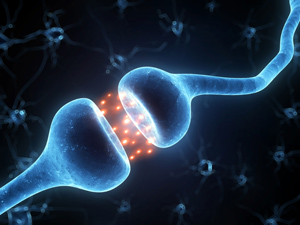October 7, 2013 - By Bruce Goldman

Thomas Südhof won a Nobel prize for his work in understanding how nerve cells communicate. They use junctions known as synapses to transmit chemical messengers to each other.
Synapses are junctions in the nervous system where information, in the form of chemical messengers called neurotransmitters, is passed from one neuron — or nerve cell — to another.
The firing patterns of our synapses underwrite our consciousness, emotions and behavior. The simple act of taking a step forward or tasting a doughnut requires millions of simultaneous and precise synaptic firing events throughout the brain and peripheral nervous system.
There are an estimated 200 billion neurons in a healthy adult brain. Any single neuron may share synaptic contacts with as few as one, or as many as 1 million, other neurons (the median is somewhere in the vicinity of 10,000), meaning that that the human brain likely holds 2 quadrillion synapses.
Much of a neuron can be visualized as a long, hollow cord whose outer surface conducts electrical impulses in one direction. At various points along this cordlike extension are bulbous nozzles known as presynaptic terminals, each one housing myriad tiny, balloon-like vesicles containing neurotransmitters and each one abutting a downstream (or postsynaptic) neuron. When an electrical impulse traveling along a neuron reaches a presynaptic terminal, calcium from outside the neuron floods in through channels that open temporarily in the terminal. A portion of the neurotransmitter-containing vesicles fuse with the terminal's outer membrane and spill their contents into the narrow gap separating it from the postsynaptic neuron's receiving end.
Thomas Südhof, MD, professor of molecular and cellular physiology at the Stanford School of Medicine, along with other researchers, identified integral protein components critical to the membrane-fusion process. Südhof shares the 2013 Nobel Prize in Physiology or Medicine for his work.
Südhof purified key protein constituents sticking out of the surfaces of neurotransmitter-containing vesicles, protruding from nearby presynaptic-terminal membranes, or bridging them. Then, using biochemical, genetic and physiological techniques, he elucidated the ways in which the interactions among these proteins contribute to carefully orchestrated membrane fusion: As a result, synaptic transmission is today one of the best-understood phenomena in neuroscience.
The proteins Südhof has focused on for close to three decades are disciplined specialists. They recruit vesicles, bring them into "docked" positions near the presynaptic terminal, herd calcium channels to the terminal membrane, and, cued by calcium, interweave like two sides of a zipper and force the vesicles into such close contact with the terminal membrane that they fuse with it and release neurotransmitters into the synaptic gap.
Although these specialists perform defined roles at the synapses, similar proteins, discovered later by Südhof and others, play comparable roles in other biological processes ranging from hormone secretion to fertilization of an egg during conception to immune cells' defense against foreign invaders.
Südhof started focusing on the workings of the synapse in the early 1980s. It was then known that presynaptic terminals are filled with tens to hundreds of small synaptic vesicles, and that the release of these vesicles' contents were triggered by calcium. But nobody had any idea how any of it actually worked. Südhof's research has helped to solve that riddle.
About Stanford Medicine
Stanford Medicine is an integrated academic health system comprising the Stanford School of Medicine and adult and pediatric health care delivery systems. Together, they harness the full potential of biomedicine through collaborative research, education and clinical care for patients. For more information, please visit med.stanford.edu.